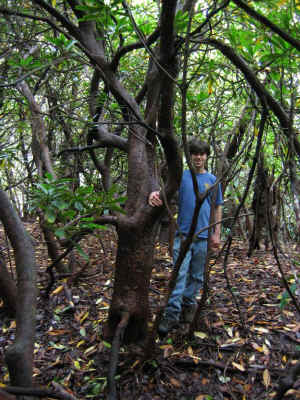| Rhododendron
and Hemlock |
Ernie
Ostuno |
| Oct
16, 2006 08:24 PDT |
Bob,
Your understory tree measurements are probably every bit
as important as the more attention-getting overstory
measurements in
quantifying the health and vitality of an old growth site. Also,
this
might be an effective way to measure/document the impact of
overgrazing
by deer in recent decades.
I've noticed a great variability in understory characteristics
at old
growth sites. I've also noticed that most of the impressive old
growth
hemlock sites in PA had large rhododendron. Has anyone done any
height/age measuring of rhododendron? Is there some type of
symbiotic
relationship between hemlock and rhodo, besides the hemlock
providing
lots of shade? We sometimes have a tendency to ignore some
members of
the old growth ecosystem or see them as merely obstacles to be
"surfed"
to get to the beloved giants.
Ernie
|
| Re: Rhododendron
and Hemlock |
Jess
Riddle |
| Oct
17, 2006 17:28 PDT |
Hello Ernie,
Good observation about the hemlock and rhododendron. I can't
speak
for the northeast, but in the southern Appalachians, large
hemlocks
and dense tangles of rosebay rhododendron often go together.
Both
species grow relatively well in acidic soils and have a
relatively low
fire tolerance. Consequently, positive neighborhood effects for
each
species own seedlings wind up also benefiting the other species;
the
foliage of both species acidify the soil and their combined
dense
shade retain moisture and inhibit fires. Oddly enough, I suspect
rhododendron also benefits hemlock by suppressing tree
regeneration;
in thick tangles of rhododendron, trees can only regenerate on
top of
logs, which hemlock does well, so hemlock seedlings have fewer
species
to compete with and a thinner mid-canopy above the rhododendron.
However, hemlock can reach immense sizes without help from
rhododendron, for instance the third largest hemlock in the
Smokies is
16' cbh and 143' with hardly any rhododendron within sight. And
the
thickest rhododendron occurs in spruce forests on in balds
without any
overstory tree canopy.
Jess
|
| Re: Rhododendron
and Hemlock |
Edward
Frank |
| Oct
17, 2006 17:36 PDT |
Jess, ENTS,
Last year at the Forest Summit, you and Will showed me a photo
of a
massively thick Rhododendron. Where was that specimen from? I
would love
to have the photo for the website. Are the stems in a single
clump
typically clones of each other? Does anyone have any idea how
old individual
stems of rhododendron can be? It might be a case similar to
creosote bush
in which the age of a clump that spreads by root sprouts may be
significantly older than individual stems.
Ed
|
| Re:
Rhododendrons & Hemlock |
Jess
Riddle |
| Oct
18, 2006 16:18 PDT |
Ed,
Ents,
If I thinking of the same large rhododendron, it grows outside
of
Black Mountain, NC on private property. Will has the photograph.

Will Blozan writes: "Here is a shot of the large Rhododendron maximum in Black Mountain, NC. It is
38" girth X 24' height X 24' average spread. It is likely a volume champion as well and Jess and I have thought of measuring it to see how much wood it contains."
Oct 22, 2006
|
I've seen multiple stems growing out of a single burl of wood at
the
base, and stems commonly have small sprouts at the base, so all
the
stems in a clump must be the same genetic individual. As far as
I
know, entire thickets of rhododendron are often a single
individual,
similar to aspen forests. Will has been keen on coring
rhododendron
in our Tsuga Search plots, so we have recently collected a few
cores
from rhododendron over four inches dbh in old-growth hemlock
forests.
Half of the cores had over 100 rings.
I would not be at all surprised if rhododendron root systems
could
live for thousands of years, but I have absolutely hard no
evidence to
back up that opinion. Fungal attacks can occasional kill an acre
of
rhododendron here or there, but I haven't seen them eliminate
rhododendron from an entire area. Rhododendron generally scoffs
at
storms. Fires, even low intensity ones, will kill rhododendron
back
to the ground, but it readily resprouts. Intense fires can kill
the
root systems, but rhododendron often grows in very moist sites.
Lee
Frelich writes about severe windthrow followed by fire being
able to
end sugar-maple hemlock dominance, and such a scenario could be
a
major threat to rhododendron even on moist sites. However, I
would
thick rhododendron would have at least occasional refuges that
would
allow small parts of a colony to survive and reestablish the
thicket.
Hence, I think the incredibly dense tangles of rosebay
rhododendron in
southern Appalachian spruce forests, with cool climates and
80"+ of
rain annually, would be very difficult to kill between major
changes
of climate.
Jess
|
| Re:
Rhododendrons & Hemlocks |
Jess
Riddle |
| Oct
18, 2006 16:35 PDT |
Ernie,
The areas where rhododendron grows without any overstory trees,
known
as balds, heath balds, slicks, or hells, typically occur on
exposed
ridges at relatively high elevations on exposed ridges. I don't
think
they range as far north as Pennsylvania, but I'm not sure. I
think
the latest theory on their formation is that they follow severe
fires
in spruce forest. The ridges burn to such an extent that only a
layer
of charcoal is left on the bedrock. The dense growth of
rhododendrons, mountain laurel, and occasionally winterberry and
other
shrubs and vines excludes tree regeneration. High concentrations
of
aluminum in the soil also deter species with weaker
constitutions.
Peter S. White has a nice paper on heath balds available as a
pdf at
http://www.bio.unc.edu/faculty/white/Reprints/White_Wilds_Stratton.pdf
Jess
|
|